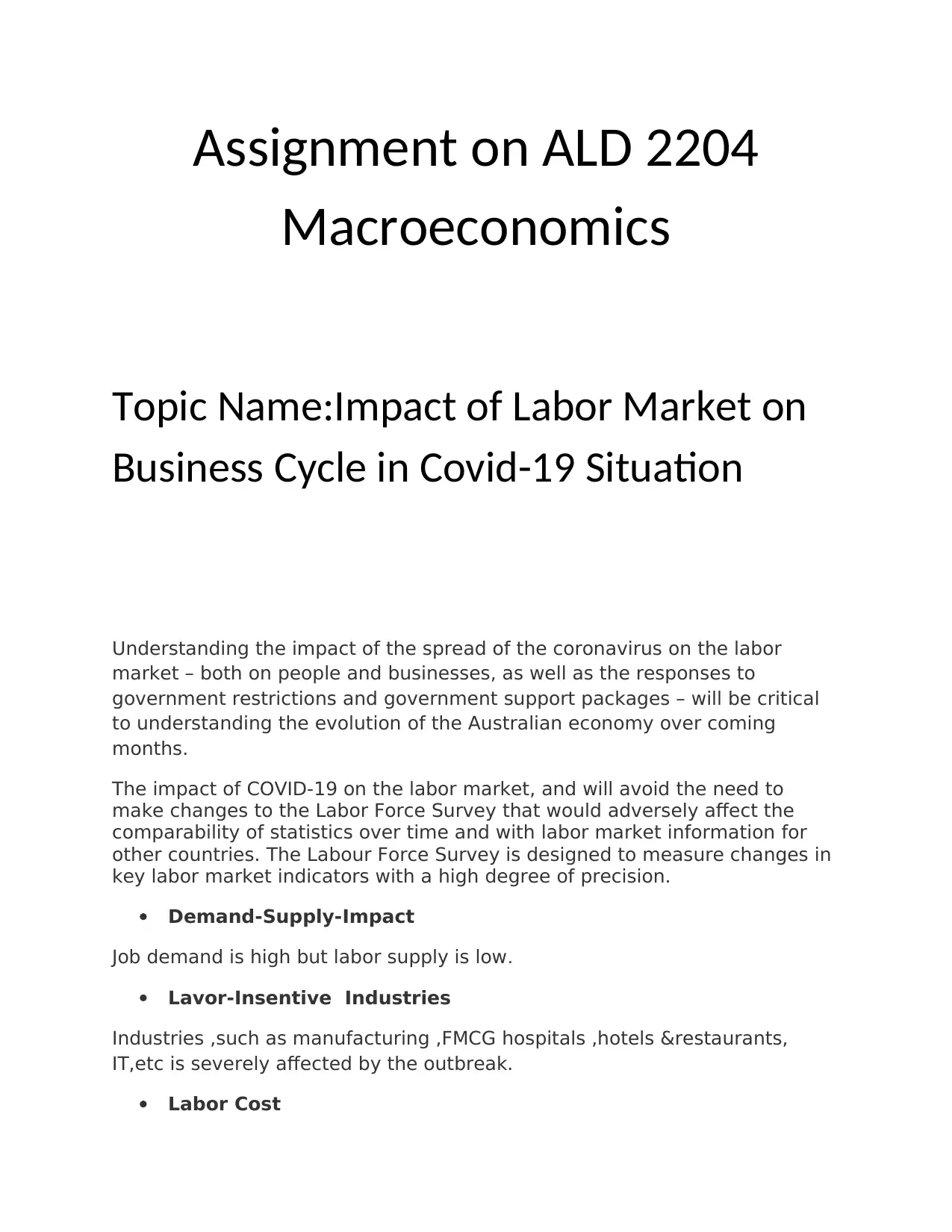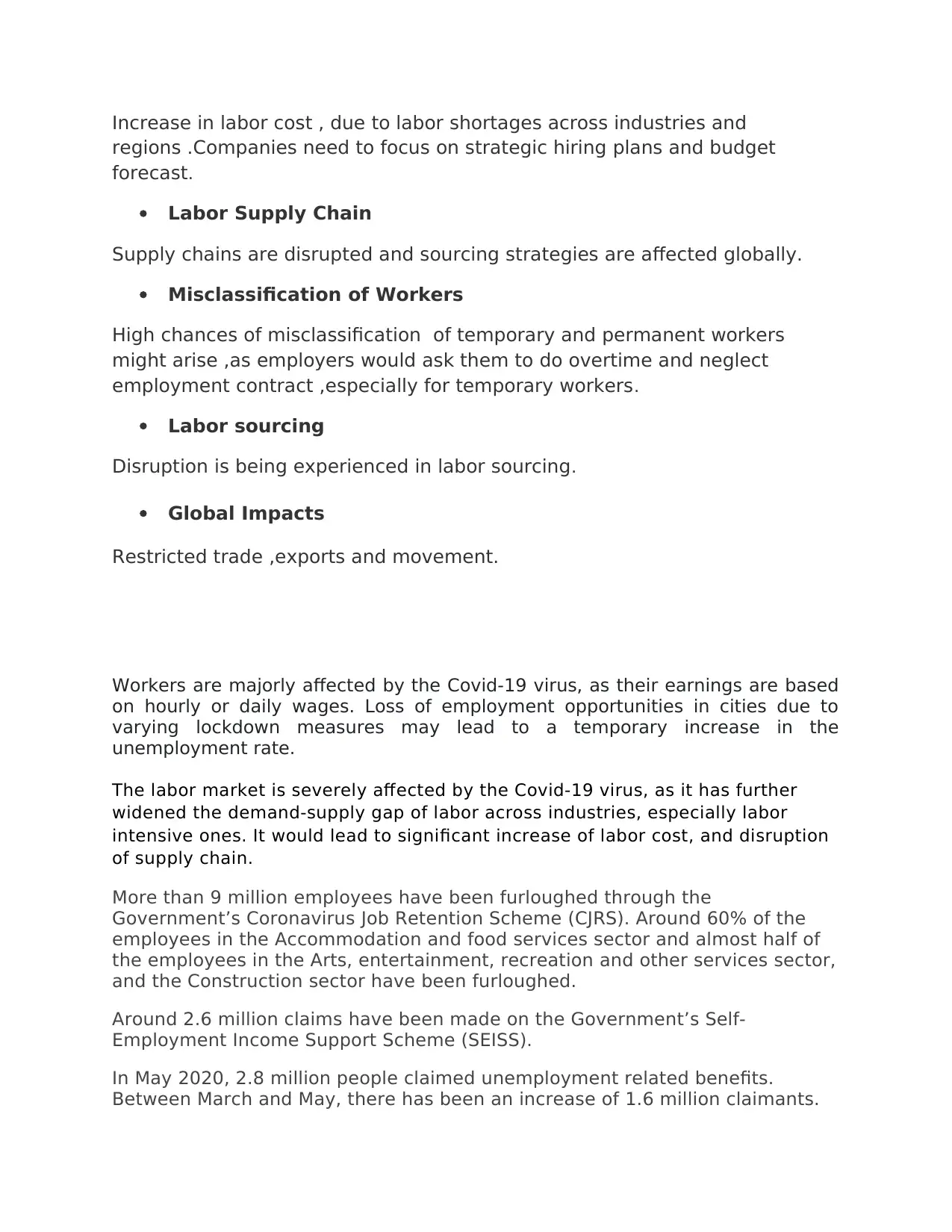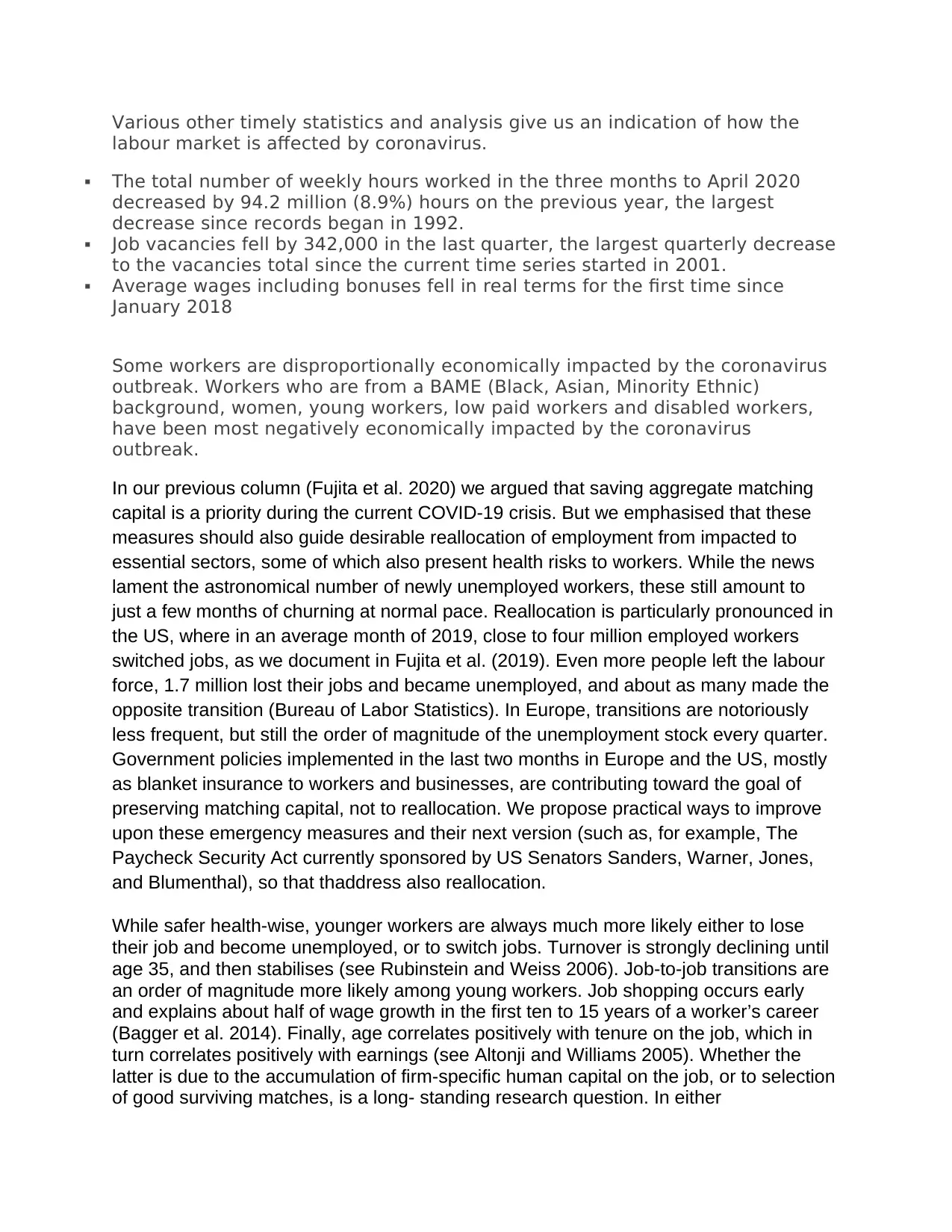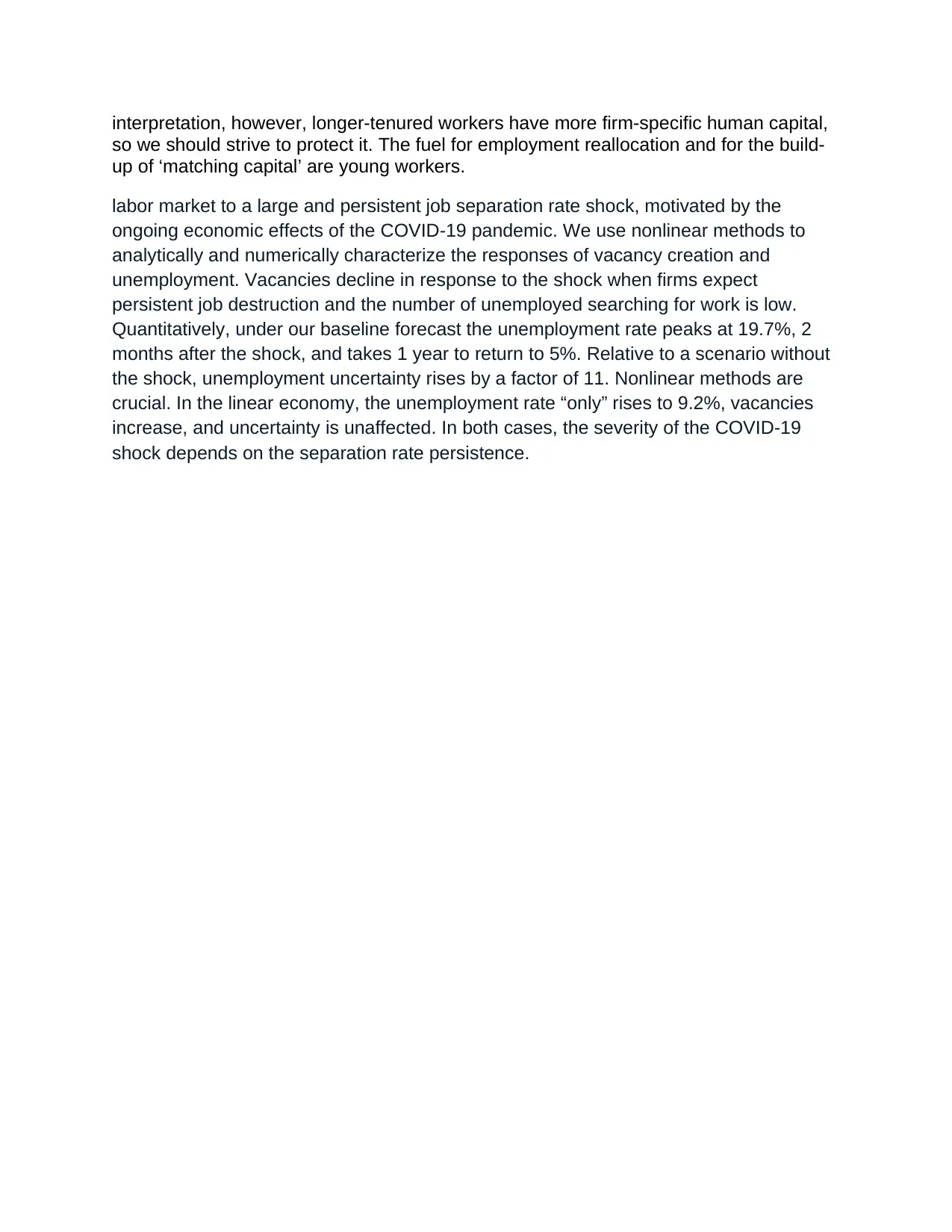Analyzing the Impact of Labor Market on Business Cycle in COVID-19
VerifiedAdded on 2022/10/27
|4
|1199
|14
Report
AI Summary
This report examines the profound impact of the COVID-19 pandemic on the Australian labor market. It analyzes the effects on key indicators such as unemployment, job vacancies, and labor costs. The report highlights the disruption of supply chains, the misclassification of workers, and the disproportionate economic impact on specific groups, including BAME workers, women, young workers, and low-paid employees. It discusses the role of government policies, such as the Coronavirus Job Retention Scheme (CJRS) and the Self-Employment Income Support Scheme (SEISS), and their effects on preserving matching capital. The analysis also explores the reallocation of employment from impacted to essential sectors, and proposes improvements to emergency measures. The study uses nonlinear methods to characterize the responses of vacancy creation and unemployment, providing quantitative forecasts and insights into the persistence of the labor market shock. Overall, the report provides a comprehensive overview of the challenges and dynamics within the labor market during the COVID-19 crisis.

Assignment on ALD 2204
Macroeconomics
Topic Name:Impact of Labor Market on
Business Cycle in Covid-19 Situation
Understanding the impact of the spread of the coronavirus on the labor
market – both on people and businesses, as well as the responses to
government restrictions and government support packages – will be critical
to understanding the evolution of the Australian economy over coming
months.
The impact of COVID-19 on the labor market, and will avoid the need to
make changes to the Labor Force Survey that would adversely affect the
comparability of statistics over time and with labor market information for
other countries. The Labour Force Survey is designed to measure changes in
key labor market indicators with a high degree of precision.
Demand-Supply-Impact
Job demand is high but labor supply is low.
Lavor-Insentive Industries
Industries ,such as manufacturing ,FMCG hospitals ,hotels &restaurants,
IT,etc is severely affected by the outbreak.
Labor Cost
Macroeconomics
Topic Name:Impact of Labor Market on
Business Cycle in Covid-19 Situation
Understanding the impact of the spread of the coronavirus on the labor
market – both on people and businesses, as well as the responses to
government restrictions and government support packages – will be critical
to understanding the evolution of the Australian economy over coming
months.
The impact of COVID-19 on the labor market, and will avoid the need to
make changes to the Labor Force Survey that would adversely affect the
comparability of statistics over time and with labor market information for
other countries. The Labour Force Survey is designed to measure changes in
key labor market indicators with a high degree of precision.
Demand-Supply-Impact
Job demand is high but labor supply is low.
Lavor-Insentive Industries
Industries ,such as manufacturing ,FMCG hospitals ,hotels &restaurants,
IT,etc is severely affected by the outbreak.
Labor Cost
Paraphrase This Document
Need a fresh take? Get an instant paraphrase of this document with our AI Paraphraser

Increase in labor cost , due to labor shortages across industries and
regions .Companies need to focus on strategic hiring plans and budget
forecast.
Labor Supply Chain
Supply chains are disrupted and sourcing strategies are affected globally.
Misclassification of Workers
High chances of misclassification of temporary and permanent workers
might arise ,as employers would ask them to do overtime and neglect
employment contract ,especially for temporary workers.
Labor sourcing
Disruption is being experienced in labor sourcing.
Global Impacts
Restricted trade ,exports and movement.
Workers are majorly affected by the Covid-19 virus, as their earnings are based
on hourly or daily wages. Loss of employment opportunities in cities due to
varying lockdown measures may lead to a temporary increase in the
unemployment rate.
The labor market is severely affected by the Covid-19 virus, as it has further
widened the demand-supply gap of labor across industries, especially labor
intensive ones. It would lead to significant increase of labor cost, and disruption
of supply chain.
More than 9 million employees have been furloughed through the
Government’s Coronavirus Job Retention Scheme (CJRS). Around 60% of the
employees in the Accommodation and food services sector and almost half of
the employees in the Arts, entertainment, recreation and other services sector,
and the Construction sector have been furloughed.
Around 2.6 million claims have been made on the Government’s Self-
Employment Income Support Scheme (SEISS).
In May 2020, 2.8 million people claimed unemployment related benefits.
Between March and May, there has been an increase of 1.6 million claimants.
regions .Companies need to focus on strategic hiring plans and budget
forecast.
Labor Supply Chain
Supply chains are disrupted and sourcing strategies are affected globally.
Misclassification of Workers
High chances of misclassification of temporary and permanent workers
might arise ,as employers would ask them to do overtime and neglect
employment contract ,especially for temporary workers.
Labor sourcing
Disruption is being experienced in labor sourcing.
Global Impacts
Restricted trade ,exports and movement.
Workers are majorly affected by the Covid-19 virus, as their earnings are based
on hourly or daily wages. Loss of employment opportunities in cities due to
varying lockdown measures may lead to a temporary increase in the
unemployment rate.
The labor market is severely affected by the Covid-19 virus, as it has further
widened the demand-supply gap of labor across industries, especially labor
intensive ones. It would lead to significant increase of labor cost, and disruption
of supply chain.
More than 9 million employees have been furloughed through the
Government’s Coronavirus Job Retention Scheme (CJRS). Around 60% of the
employees in the Accommodation and food services sector and almost half of
the employees in the Arts, entertainment, recreation and other services sector,
and the Construction sector have been furloughed.
Around 2.6 million claims have been made on the Government’s Self-
Employment Income Support Scheme (SEISS).
In May 2020, 2.8 million people claimed unemployment related benefits.
Between March and May, there has been an increase of 1.6 million claimants.

Various other timely statistics and analysis give us an indication of how the
labour market is affected by coronavirus.
The total number of weekly hours worked in the three months to April 2020
decreased by 94.2 million (8.9%) hours on the previous year, the largest
decrease since records began in 1992.
Job vacancies fell by 342,000 in the last quarter, the largest quarterly decrease
to the vacancies total since the current time series started in 2001.
Average wages including bonuses fell in real terms for the first time since
January 2018
Some workers are disproportionally economically impacted by the coronavirus
outbreak. Workers who are from a BAME (Black, Asian, Minority Ethnic)
background, women, young workers, low paid workers and disabled workers,
have been most negatively economically impacted by the coronavirus
outbreak.
In our previous column (Fujita et al. 2020) we argued that saving aggregate matching
capital is a priority during the current COVID-19 crisis. But we emphasised that these
measures should also guide desirable reallocation of employment from impacted to
essential sectors, some of which also present health risks to workers. While the news
lament the astronomical number of newly unemployed workers, these still amount to
just a few months of churning at normal pace. Reallocation is particularly pronounced in
the US, where in an average month of 2019, close to four million employed workers
switched jobs, as we document in Fujita et al. (2019). Even more people left the labour
force, 1.7 million lost their jobs and became unemployed, and about as many made the
opposite transition (Bureau of Labor Statistics). In Europe, transitions are notoriously
less frequent, but still the order of magnitude of the unemployment stock every quarter.
Government policies implemented in the last two months in Europe and the US, mostly
as blanket insurance to workers and businesses, are contributing toward the goal of
preserving matching capital, not to reallocation. We propose practical ways to improve
upon these emergency measures and their next version (such as, for example, The
Paycheck Security Act currently sponsored by US Senators Sanders, Warner, Jones,
and Blumenthal), so that thaddress also reallocation.
While safer health-wise, younger workers are always much more likely either to lose
their job and become unemployed, or to switch jobs. Turnover is strongly declining until
age 35, and then stabilises (see Rubinstein and Weiss 2006). Job-to-job transitions are
an order of magnitude more likely among young workers. Job shopping occurs early
and explains about half of wage growth in the first ten to 15 years of a worker’s career
(Bagger et al. 2014). Finally, age correlates positively with tenure on the job, which in
turn correlates positively with earnings (see Altonji and Williams 2005). Whether the
latter is due to the accumulation of firm-specific human capital on the job, or to selection
of good surviving matches, is a long- standing research question. In either
labour market is affected by coronavirus.
The total number of weekly hours worked in the three months to April 2020
decreased by 94.2 million (8.9%) hours on the previous year, the largest
decrease since records began in 1992.
Job vacancies fell by 342,000 in the last quarter, the largest quarterly decrease
to the vacancies total since the current time series started in 2001.
Average wages including bonuses fell in real terms for the first time since
January 2018
Some workers are disproportionally economically impacted by the coronavirus
outbreak. Workers who are from a BAME (Black, Asian, Minority Ethnic)
background, women, young workers, low paid workers and disabled workers,
have been most negatively economically impacted by the coronavirus
outbreak.
In our previous column (Fujita et al. 2020) we argued that saving aggregate matching
capital is a priority during the current COVID-19 crisis. But we emphasised that these
measures should also guide desirable reallocation of employment from impacted to
essential sectors, some of which also present health risks to workers. While the news
lament the astronomical number of newly unemployed workers, these still amount to
just a few months of churning at normal pace. Reallocation is particularly pronounced in
the US, where in an average month of 2019, close to four million employed workers
switched jobs, as we document in Fujita et al. (2019). Even more people left the labour
force, 1.7 million lost their jobs and became unemployed, and about as many made the
opposite transition (Bureau of Labor Statistics). In Europe, transitions are notoriously
less frequent, but still the order of magnitude of the unemployment stock every quarter.
Government policies implemented in the last two months in Europe and the US, mostly
as blanket insurance to workers and businesses, are contributing toward the goal of
preserving matching capital, not to reallocation. We propose practical ways to improve
upon these emergency measures and their next version (such as, for example, The
Paycheck Security Act currently sponsored by US Senators Sanders, Warner, Jones,
and Blumenthal), so that thaddress also reallocation.
While safer health-wise, younger workers are always much more likely either to lose
their job and become unemployed, or to switch jobs. Turnover is strongly declining until
age 35, and then stabilises (see Rubinstein and Weiss 2006). Job-to-job transitions are
an order of magnitude more likely among young workers. Job shopping occurs early
and explains about half of wage growth in the first ten to 15 years of a worker’s career
(Bagger et al. 2014). Finally, age correlates positively with tenure on the job, which in
turn correlates positively with earnings (see Altonji and Williams 2005). Whether the
latter is due to the accumulation of firm-specific human capital on the job, or to selection
of good surviving matches, is a long- standing research question. In either
⊘ This is a preview!⊘
Do you want full access?
Subscribe today to unlock all pages.

Trusted by 1+ million students worldwide

interpretation, however, longer-tenured workers have more firm-specific human capital,
so we should strive to protect it. The fuel for employment reallocation and for the build-
up of ‘matching capital’ are young workers.
labor market to a large and persistent job separation rate shock, motivated by the
ongoing economic effects of the COVID-19 pandemic. We use nonlinear methods to
analytically and numerically characterize the responses of vacancy creation and
unemployment. Vacancies decline in response to the shock when firms expect
persistent job destruction and the number of unemployed searching for work is low.
Quantitatively, under our baseline forecast the unemployment rate peaks at 19.7%, 2
months after the shock, and takes 1 year to return to 5%. Relative to a scenario without
the shock, unemployment uncertainty rises by a factor of 11. Nonlinear methods are
crucial. In the linear economy, the unemployment rate “only” rises to 9.2%, vacancies
increase, and uncertainty is unaffected. In both cases, the severity of the COVID-19
shock depends on the separation rate persistence.
so we should strive to protect it. The fuel for employment reallocation and for the build-
up of ‘matching capital’ are young workers.
labor market to a large and persistent job separation rate shock, motivated by the
ongoing economic effects of the COVID-19 pandemic. We use nonlinear methods to
analytically and numerically characterize the responses of vacancy creation and
unemployment. Vacancies decline in response to the shock when firms expect
persistent job destruction and the number of unemployed searching for work is low.
Quantitatively, under our baseline forecast the unemployment rate peaks at 19.7%, 2
months after the shock, and takes 1 year to return to 5%. Relative to a scenario without
the shock, unemployment uncertainty rises by a factor of 11. Nonlinear methods are
crucial. In the linear economy, the unemployment rate “only” rises to 9.2%, vacancies
increase, and uncertainty is unaffected. In both cases, the severity of the COVID-19
shock depends on the separation rate persistence.
1 out of 4
Related Documents
Your All-in-One AI-Powered Toolkit for Academic Success.
+13062052269
info@desklib.com
Available 24*7 on WhatsApp / Email
![[object Object]](/_next/static/media/star-bottom.7253800d.svg)
Unlock your academic potential
Copyright © 2020–2025 A2Z Services. All Rights Reserved. Developed and managed by ZUCOL.




